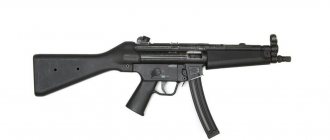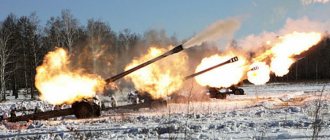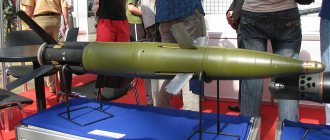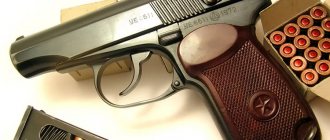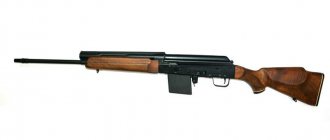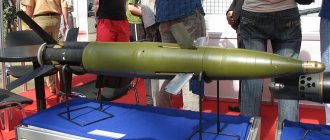The first flintlock pistols (pistols) appeared in the 15th century. By design, it was a shortened trunk placed on a block of wood. A wick was used as a fuse (later replaced by a flintlock). The weapons in question at that time differed in design and purpose. Short models were used for point-blank shooting, and elongated cavalry counterparts hit a target at a distance of 30-40 meters.
Glock 17 (Austria)
Glock 17 (Glock 17) is an Austrian pistol developed by Glock for the needs of the Austrian army. It became the first weapon developed by this company. The resulting model turned out to be quite successful and convenient for use, thanks to which it was later adopted by the Austrian army under the designation P80. Due to its combat qualities and reliability, it has become widespread as a civilian self-defense weapon. Available in various versions for different cartridges (9x19 mm Parabellum, .40 S&W, 10 mm Auto, .357 SIG, .45 ACP and .45 GAP).
A design feature is the absence of a safety box and trigger. The pistol is mostly made of high-strength heat-resistant plastic up to 200 °C. This makes the Glock 17 lightweight and extremely durable. The principle of operation is “snatch and shoot”, there is no safety, but the shot will not occur without fully pressing the “safe action” trigger. Composed of 33 parts, partial disassembly is carried out in seconds
Colt M1911 (USA)
M1911 is a self-loading pistol chambered for . 45 ACP.
Developed by John Moses Browning in 1908 under the name Colt-Browning (US Patent 984519, Feb. 14, 1911). It was in service with the US Armed Forces from 1911 to 1985, and is still authorized for use today. One of the most famous and popular pistols of this company. Widely used and used by the US police and army. It was subsequently modernized and given the name M1911A1 and has been in service ever since without any significant changes. True, the M1911A1 model also exists in a version chambered for .38ACP caliber cartridges.
The automatic pistol operates on the principle of recoil of the barrel with a short stroke. The barrel is connected to the frame using a movable earring, which provides locking and unlocking of the barrel. Under the influence of recoil, the barrel begins to move backward along with the bolt-casing, but the earring, turning on a fixed axis, forces the breech to lower, disengaging the lugs of the barrel from engaging with the grooves on the inner surface of the bolt-casing.
The theory stated that since the barrel began to decline before the bullet left the bore, its movement would adversely affect shooting accuracy, but in reality no one complained about the accuracy of the M1911. Trigger trigger, single action, with open trigger arrangement. The drummer is inertial. It is shorter than the channel in which it moves and is spring-loaded. After hitting the trigger, he goes forward, hits the cartridge primer and immediately hides back into the channel. The pistol has two safeties - an automatic one, which turns off when covered with your hand, and a flag safety device, which blocks the trigger and bolt when turned on.
The return spring is located under the barrel. Open sight. Model M1911A1 (in the picture) differs very slightly. The profile of the rear end of the handle and the shape of the frame safety lever have been changed, and the frame behind the trigger is slightly concave. The trigger shank has also changed (instead of a round head there is a spoke).
Pocket pistols and revolvers
Three-barrel and three-shot Marston pistol, produced in the USA in 1864, .22 caliber. The rarest of the Marstons. Only about 300 pieces were made. The barrels, located one above the other, are deflected down for loading. Factory engraved brass frame and walnut handle
“The revolver, thrown away by Dunya and flying towards the door, suddenly caught his eye.
He picked it up and examined it. It was a small, pocket three-strike revolver, of an old design; there are still two charges and one primer left in it. You could shoot once. He thought, put the revolver in his pocket, took his hat and went out.” "Crime and Punishment". Fyodor Dostoevsky History of firearms.
An interesting design is described in Dostoevsky’s novel - a three-strike revolver (!) with three primers, and therefore three barrels. And what? So, were there such people or was it the author’s invention? No, there were such “revolvers”, but it would be more correct to call this weapon a pistol, because the main feature of a revolver was a rotating drum, and there was only one barrel.
Pistol, circa 1835, .28 caliber: Allen patent; engraved frame; The handle is made of walnut wood with oval overlays made of German wood. Manufacturer: Grafton, Massachusetts. Photo courtesy of Alain Daubresse
In the previous article dedicated to the “Queen Anne pistols,” we already talked about the appearance of this specific weapon. But... how did it subsequently develop? This is exactly what we will talk about today, and, of course, we will look at certain samples of pistols “for the pocket”.
Another interesting example of a pistol. Photo courtesy of Alain Daubresse
Let's start with the fact that after the invention of caps, pocket pistols simply experienced a rebirth, and their popularity increased even more. The fact is that due to the design and operation of the flintlock, its trigger had to protrude quite significantly above the box-shaped receiver and, accordingly, could easily catch on the pocket lining.
The capsule lock had no such drawback. Its trigger could easily be made self-cocking and worn with a capsule attached to the fire tube. In this form, and even with the trigger folded, such a pistol had a “streamlined shape.” There was simply nothing to catch on the lining of the pockets, and if so, since such a convenient and “modern” weapon appeared, then why not buy it?
Single-shot pistol with a lower trigger. By B. Bosworth, Warren, Rhode Island, circa 1850s. .31 caliber, 8" barrel length, part octagonal, part round, with brass front sight. The pistol's brass frame has a steel hammer and trigger. Photo courtesy of Alain Daubresse
However, the capsule literally freed up the designers’ hands, so that through their efforts, completely unusual samples began to appear not with an upper, but with a lower location of the fire tube and, accordingly, the trigger striking it. The barrel was also unscrewed with a special key, which allowed the bullet to be inserted into the barrel “with a stop” and provided the pistol with a strong fight.
A long barrel means the combat is stronger and the fire accuracy is higher. This is how “long-barreled pocket pistols” appeared, which also had the trigger and fire tube located at the bottom, which was convenient, since there was simply nothing for such a pistol to catch on the lining.
It is interesting that some of these pistols received an original shaped handle, most similar to the handle of a cane. By the way, they were often combined with a cane. It’s convenient, needless to say... You’re walking so-so, leaning on a “stick” late in the evening, doing exercise before going to bed, and you’re r-a-az, and a robber attacks you. And you - you take a pistol out of your cane and - bang point-blank, and there is no robber, and you calmly go on your walk! However, there were also special shooting canes, very original devices, and we will definitely tell you about them someday!
H. J. Hale Pistol, Bristol, Connecticut and Worcester, Massachusetts. Circa 1850s .28 caliber, 6-inch octagonal, partially round barrel, with copper or brass front sights. Photo courtesy of Alain Daubresse
Hale even began producing sets of two of these pistols, with a full set of accessories. Moreover, if desired, they could also serve as duels - why not? Mahogany body with brass carrying handle, lock and two latches; brown velvet lining, combined copper/brass powder flask, bullet gun, cleaning rod and tin for percussion caps. Photo courtesy of Alain Daubresse
Well, as always, as soon as single-shot pistols of this type appeared, gunsmith designers became concerned with creating multi-shot weapons. In particular, the American one created a three-barreled and three-shot pistol with a rotary toggle switch, by turning which the trigger was placed against the corresponding .22 caliber cartridge. Photo courtesy of Alain Daubresse
The barrel block was locked with a rotating top plate. Photo courtesy of Alain Daubresse
The plate rotated and the barrels were folded down for loading. Photo courtesy of Alain Daubresse
The plate rotated and the barrels folded down for loading. Photo courtesy of Alain Daubresse
Marston also produced capsule pepperboxes. Rotate the block of barrels - a shot, turn - a shot. At the same time, all capsules were protected from external influences. Photo courtesy of Alain Daubresse
Three barrels - good! And four is even better! Pistol "Cohn and S. Marston", J. Cohn and S.W. Marston, New York. Circa 1850s .28 caliber, rotating barrel block with pairs of barrels, and with a brass front sight on each pair of barrels; patent 1851. Frame made of silver-plated brass; ring trigger; varnished walnut handle cheeks. Photo courtesy of Alain Daubresse
In 1883, French gunsmith and inventor Jacques Turbiot received a patent for a strange-looking pocket weapon in which cartridges were arranged radially inside a disk, called "Le Protector".
"Protector" - US Patent
The device resembled a wrist expander. The disk with the barrel contained another disk-magazine with a radial arrangement of cartridges. The trigger was located inside this disk-magazine, and as soon as the shooter squeezed the spring of the firing device with the back of his hand, he hit the cartridge primer. That is, by using a brush and squeezing and unclenching the spring, it was possible to quickly empty the entire magazine, while the barrel itself passed between the fingers.
The original model of the French "Protector". Photo courtesy of Alain Daubresse
The pistol was produced in France until the mid-90s of the 19th century; in 1892, the Americans bought a license for its production. Due to legal disputes, American Protectors were produced in very small quantities. American-made pistols were called Chicago Palm Pistol or Chicago Palm Protector.
6 and 8 mm cartridges for the "Protector". Photo courtesy of Alain Daubresse
The French versions came in two calibers: 6 and 8 mm, with 40 mm barrels for the smaller caliber model and 45 mm for the larger one. Accordingly, the first model had a magazine with 10 rounds, and the second with 7.
American model of the "Projector" with the stamp "CHICAGO FIRE ARMS CO CHICAGO ILL" in .32 caliber. Photo courtesy of Alain Daubresse
Her device. Photo courtesy of Alain Daubresse
In the mid-19th century, not only pistols, but also revolvers were pocket-sized. For example, these included the Massachusetts Arms Company revolvers, which were a pocket version of the Wesson and Levitt revolver.
Revolver of the Massachusetts Arms Company, produced in 1850-1851. About 1,000 examples were produced in .31 caliber with a 6-shot cylinder. Photo courtesy of Alain Daubresse
The same model, but with a mother-of-pearl handle. Photo courtesy of Alain Daubresse
In order to simplify the revolver as much as possible and make it as small as possible, its creators decided not to use primers for ignition, but used the original system according to Maynard’s patent, in which a piston tape, similar to the tape for children’s toy pistols, was used to ignite the charges in the drum, but, of course, , incomparably greater power.
The revolver was very easy to disassemble... Photo courtesy of Alain Daubresse
The tape with capsules was placed in a slot on the body of the revolver and fed to the fire tube by pressing the trigger. Accordingly, the drum, turning, stood opposite it with a hole through which the flame from the primer reached the charge. The trigger guard was gilded, the cheeks of the handle were mother-of-pearl.
Maynard's "store" design. Photo courtesy of Alain Daubresse
However, larger models of this revolver were also produced. But they were capsule ones. The mechanism is the same, self-cocking.
Capsule revolver of the Massachusetts Arms Company. Photo courtesy of Alain Daubresse
This is how he figured it out... Photo courtesy of Alain Daubresse
This is his drum.
Already with sockets for capsules. Photo courtesy of Alain Daubresse As you can see, those who wanted to put a pistol in their pocket or carry it in a lady's muff at that time had a wide choice of a wide variety of models ... “pocket weapons”.
Walther P38 (Germany)
The P38 pistol was developed back in the second half of the thirties specifically as an army pistol. Its first user was Sweden, which purchased a small number of Walther HP pistols (Heeres Pistole, that is, army pistol) in 1938; in 1940, under the official designation Pistole 38, it was adopted by the Wehrmacht and was widely used during the Second World War. The production of P38 pistols continued immediately after the end of the war in 1945-46, from military stocks, and was carried out under the supervision of the French occupation authorities. In the mid-1950s, the Carl Walther company began to rise from its post-war ruins.
In 1957, the Bundeswehr adopted the P1 pistol, which differed from the first P38 only in its aluminum frame. At the same time, the commercial version of the same pistol was still called P38. Production of commercial steel frame P38 pistols in the post-war period was fairly small. In 1975, a reinforcing hexagonal cross-section rod was introduced into the design of the P1/P38 pistols, located in a frame in the area where the barrel locking cylinder is located. In the early 1970s, to unify and modernize the very diverse fleet of pistols of the German police, the P4 pistol was developed and approved for use, which was a modification of the P1/P38 pistol with a shortened barrel and a modified safety mechanism. P4 pistols remained in production until 1981, being superseded by the more advanced Walther P5 model.
The top 5 best army pistols of the twentieth century have been compiled
Moscow, March 31. High power, accuracy and reliability are the main factors of a quality pistol. The modern market offers a large selection of short-barreled weapons, but pistols from the last century remain in service to this day. Among them are five of the most famous designs, the creators of which forever inscribed their name in the history of the development of weapons.
Mauser C96
The German Mauser C96 self-loading pistol was developed in 1895. The pistol had a double-row magazine that was inserted from the top. The pistol was equipped with a wooden holster-butt, which made it look like a rifle. The Mauser C96 used a 7.63 mm cartridge.
The pistol was in service with the British, Turkish and Italian armies and was used until World War II. The Mauser C96 was popular among Soviet security forces due to its power and compactness.
Stechkin automatic pistol
The pistol of Stechkin's design was developed in the late 1940s for special units. The pistol magazine was designed to hold 20 nine-millimeter rounds. The weapon has low recoil and high accuracy. The pistol did not become widespread and was discontinued in 1958. At the same time, the pistol is still valued by special forces soldiers today for its reliability and firepower.
wikipedia.org/CC BY-SA 3.0
Smith & Wesson Model 10
The Smith & Wesson Model 10 is a six-shot revolver that has been in production since 1899. In total, more than six million different modifications of this pistol were produced. The Smith & Wesson Model 10 has been used by law enforcement and military units around the world.
The revolver is simple and easy to use, and is also highly reliable. Many US police departments still use the Smith & Wesson Model 10. In addition, the pistol is very popular among civilians.
wikipedia.org / Michael E. Cumpston / CC BY-SA 4.0
Luger pistol
A nine-millimeter caliber pistol designed by Georg Luger, developed in 1898. The pistol had a comfortable handle and light weight, which ensured high shooting accuracy. The pistols were assembled by hand. At the same time, some models were decorated with engraving.
wikipedia.org/Cajda/CC BY 3.0
TT
The TT (Tula, Tokarev) self-loading pistol was developed in 1930 by Soviet designer Fedor Tokarev. The weapon had a simple design and high reliability, and was also cheap to produce. The pistol was superior to foreign models in many characteristics.
The pistol was used in the battles at Khalkhin Gol, as well as in the Soviet-Finnish war. In addition, the pistol was widely used in the Great Patriotic War. By 1953, more than 1.7 million TT samples had been produced.
wikipedia.org/SONY/CC BY 3.0
Luger P08 (Germany)
Georg Luger created the world famous Parabellum around 1898, based on the cartridge and locking system designed by Hugo Borchardt. Luger modified the Borchardt lever locking system to make it more compact. Already in 1900-1902, Switzerland adopted Parabellum Model 1900 7.65mm caliber into service with its army. A little later, Georg Luger, together with the DWM company (the main manufacturer of Parabellums in the first quarter of the twentieth century), redesigned his cartridge for a 9mm caliber bullet, and the most popular pistol cartridge in the world, 9x19mm Luger/Parabellum, was born. In 1904, the 9mm parabellum was adopted by the German Navy, and in 1908 by the German Army. Subsequently, Lugers were in service in many countries around the world, and were in service at least until the 1950s.
The Parabellum pistol (the name comes from the Latin proverb Si vis pacem, Para bellum - If you want peace, prepare for war), is a self-loading pistol with a single-action striker trigger. The pistol is built according to a scheme with a short barrel stroke and locking with a lever system. In the locked position, the levers are in the “dead center” position, rigidly fixing the bolt in the movable receiver connected to the barrel. When the entire system of levers moves back under the influence of recoil after a shot, the levers with their central axis are located on the protrusion of the spito frame, which forces them to pass the “dead point” and “fold” upward, unlocking the barrel and allowing the bolt to go back. Lugers were produced with a variety of barrel lengths - from 98 mm to 203 mm (artillery model) and more. They were also produced in a "carbine" version, with a long barrel, a removable wooden fore-end and a detachable butt. Some (early) models were equipped with an automatic safety on the back of the handle.
In general, the Parabellums were distinguished by a very comfortable handle, providing a comfortable grip and convenient aiming, and good shooting accuracy. However, they were difficult (and therefore expensive) to produce, and very sensitive to contamination.
TT (USSR)
The TT (Tula, Tokarev) pistol, as its name suggests, was developed at the Tula Arms Factory by the legendary Russian gunsmith Fedor Tokarev. The development of a new self-loading pistol, designed to replace both the standard outdated Nagan revolver model 1895, and various imported pistols in service with the Red Army, began in the second half of the 1920s. In 1930, after extensive testing, the Tokarev system pistol was recommended for adoption, and the army ordered several thousand pistols for military testing.
Pistol TT arr. For 33 years it was produced in parallel with the Nagan revolver until the beginning of the Great Patriotic War, and then completely replaced the Nagan from production. In the USSR, production of the TT continued until 1952, when it was officially replaced in the arsenal of the Soviet Army by the PM pistol of the Makarov system. The TT remained in service with the troops until the 1960s, and to this day a significant number are mothballed in army reserve warehouses. In total, approximately 1,700,000 TT pistols were produced in the USSR.
In China and Yugoslavia, TT-based pistols are still produced.
For its time, the TT pistol was a fairly advanced weapon, powerful and reliable, easy to maintain and repair. Its main disadvantages were reduced safety in handling due to the lack of full-fledged safety devices, the relatively low stopping effect of a light 7.62mm bullet, and the not very comfortable shape of the handle.
Tokarev model 1933 is built on the basis of automation, using recoil energy with a short barrel stroke. The barrel is locked by tilting it in a vertical plane using a swinging earring (similar to the Browning / Colt M1911 system). The locking lugs on the barrel are made along its entire circumference, which simplifies the manufacture of the barrel. The trigger mechanism is a hammer, single action, made in the form of a single easily removable module (for the first time in the world). There are no safety devices; for relatively safe carrying of a pistol with a cartridge in the chamber, there was a safety half-cocked trigger, however, if the trigger parts were worn out, dropping the pistol with the hammer half-cocked could lead to an accidental shot.
Pistols and revolvers
What is a modern pistol or revolver? Why are these metal and (more recently) plastic “products” so popular around the world? Perhaps because they are small in size, moderate in weight (well, almost all
